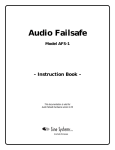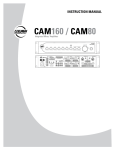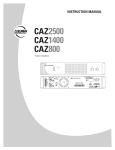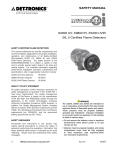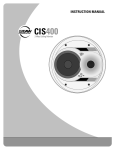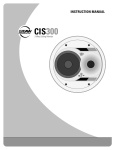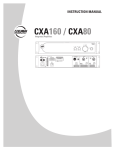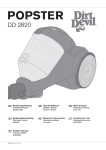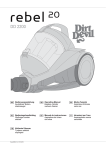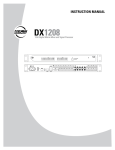Download EAW CAZ2500 Instruction manual
Transcript
INSTRUCTION MANUAL CIS961 and CIS991 High-Output Ceiling-Mounted Loudspeakers 1. SAFETY INSTRUCTIONS 1. 2. 3. 4. 5. 6. 7. 8. 9. 10. 11. 12. 13. Read these instructions. Keep these instructions. Heed all warnings. Follow all instructions. Do not use this apparatus near water. Clean only with a dry cloth. Do not block any ventilation openings. Install in accordance with the manufacturer’s instructions. Do not install near any heat sources such as radiators, heat registers, stoves, or other apparatus (including amplifiers) that produce heat. Only use attachments/accessories specified by the manufacturer. Refer all servicing to qualified service personnel. Servicing is required when the apparatus has been damaged in any way, such as liquid has been spilled or objects have fallen into the apparatus, the apparatus has been exposed to rain or moisture, does not operate normally, or has been dropped. The entire sound system must be designed in compliance with the current standards and laws regarding electrical systems. When installing and using this apparatus, keep in mind the technical specifications indicated in the dedicated section of the manual. Exposure to high sound levels can cause permanent hearing loss. The sound pressure level which leads to hearing loss varies considerably from one person to another, and depends on the duration of exposure. The U.S. Government’s Occupational Safety and Health Administration (OSHA) has established the maximum sound pressure levels that can be with stood without causing damage, which are shown in the table below. According to the OSHA regulations, any exposure over the maximum limits indicated in the table can reduce the hearing capacity of a person. To prevent potentially dangerous exposure to high sound pressure levels, anyone subjected to such levels must use suitable protection. When a EAW Commercial product capable of producing high sound levels is being used, it is therefore necessary to wear ear plugs or protective earphones when the limits shown in the table are exceeded. Consult the specifications provided in the instruction manual to know the maximum sound pressure (SPL) the loudspeaker is capable of producing. The exclamation point within an equilateral triangle is intended to alert the user of the presence of important operating and maintenance (servicing) instructions in the literature accompanying the apparatus. 14. Rigging Precautions: When mounting or suspending EAW Commercial loudspeaker enclosures, it is essential that load ratings, rigging techniques, and special safety considerations be appropriate for the installation. Use only the mounting/rigging points on the loudspeaker enclosure intended for this purpose. The user must determine the load requirements, dynamic loading, and any other contributing factors affecting the loudspeaker installation. The user must determine the proper design factor for specific applications and the required load rating of the connection to structure. Comply with all applicable federal, state, and local regulations. EAW Commercial strongly recommends the following rigging system practices: • Documentation: Thoroughly document the mounting/rigging design with detailed drawings and parts lists. • Analysis: Have a licensed structural engineer or other qualified professional review and approve the mounting/rigging design before its implementation. • Installation: Use personnel experienced and qualified for mounting/ rigging loudspeakers in accordance with and in compliance with all federal, state and local regulations. DANGER: Loudspeakers should be mounted or suspended only by persons with knowledge of the proper hardware and rigging techniques. Failure to follow these precautions may result in damage to the equipment, personal injury, or death. Duration per day (hours) Sound level (dBA) Typical example 8 90 Duo in a small club 6 92 4 95 3 97 2 100 1.5 102 1 105 0.5 110 0.25 or less 11 5 Subway train Very loud classical music Locomotive at 50 feet Loudest parts at a rock concert Contents 1. SAFETY INSTRUCTIONS....................................................2 2. INTRODUCTION...................................................................3 WARNING! This equipment has been designed to be installed by qualified professionals only! There are many factors to be considered when installing professional sound reinforcement systems, including mechanical and electrical considerations, as well as acoustic coverage and performance. EAW Commercial strongly recommends that this equipment be installed only by a professional sound installer or contractor. 3. FRONT PANEL FEATURES..................................................4 4. REAR PANEL FEATURES.....................................................5 5. INSTALLING THE LOUDSPEAKER.....................................6 6. SPECIFICATIONS...............................................................10 7. OPTIONAL KITS.................................................................16 8. SERVICE INFORMATION..................................................19 9. EAW COMMERCIAL WARRANTY...................................19 Part No. 0023640 Rev. A 03/08 © 2008 LOUD Technologies Inc. All Rights Reserved. – CIS961 and CIS991 2. INTRODUCTION FEATURES The CIS961 and CIS991 are high-output ceiling-mounted loudspeakers, designed for fixed installation into high ceiling plenum spaces or open structures. Utilizing four 5.25" LF cone woofers, four 4" MF cone woofers, and a horn-mounted compression driver, these loudspeakers deliver coherent point-source reproduction, as well as superior low-frequency dispersion. The result is superior full-range performance in any distributed loudspeaker system. • High speech intelligibility at high power levels The CIS991 offers a broader high-frequency coverage pattern than the CIS961. (Please refer to the polar diagrams on pages 12–15.) Apart from this difference the two loudspeakers are identical, and this instruction guide covers both models. • 4 x 4" MF cone woofers The loudspeakers are supplied with an integral 70V/100V line transformer, rated to a maximum of 128 watts. Tap settings are adjustable by means of a recessed rotary switch on the front bezel, and allows selection of 128, 64, 32, and 16 watt taps at 70 V, and 128, 64, and 32 watt taps at 100 V. In addition, the transformer can be bypassed, presenting an 8-ohm load to low-impedance systems. The white powder-coated 18-gauge steel back can is square in shape, and is designed to mount in a 24-inch ceiling grid. The back can includes a recessed euroblock input connector, with detachable mating plug, concealed behind a hinged metal cover plate. A ceramic screw-terminal block is also present. Four eye-bolts are supplied, and these need to be screwed into the back can by the installer, prior to suspending the assembly. The baffle/can assembly is shipped with the transducers installed. The powder-coated perforated steel grille is easily installed once the wattage tap has been selected. Optional installation kits include a 4-piece cable kit (AC-CK) for suspension, and a 4-piece square trim ring kit (AC-TRK) that dresses the baffle into suspended ceiling tile surrounds. (See page 16 for more details of these kits.) • High output and smooth low-frequency dispersion • Fast and easy installation • Seamless, deep-drawn back can • Integrated 4-point mounting system • 4 x 5.25" LF cone woofers • 1" HF horn-mounted compression driver • 70V/100V transformer built-in • 128, 64, 32, and 16 watt taps at 70 V • 128, 64, and 32 watt taps at 100 V • 8 ohm setting on selector switch (direct) • Removable grille for access to transformer taps • Euroblock Phoenix-type input connector • "BS5839 Part 8" compliant screw terminal inputs • Through-outputs for easy parallel connections to other loudspeakers • Cable strain relief • Input connection covers • Optional 4-piece cable suspension kit (AC-CK) • Optional 4-piece trim ring kit (AC-TRK) to dress the installation into 24" x 24" and 600 mm x 600 mm ceiling tile surrounds APPLICATIONS • Foreground/background music systems • Paging systems • Continuous-duty applications • Sound reinforcement systems CIS961 and CIS991 – 3. FRONT PANEL FEATURES 1. MAIN ASSEMBLY Transformer/Direct Selector The loudspeaker is supplied with the drivers, crossovers, transformer, front baffle, and rear metal can, all assembled in one unit. Do not disassemble this unit. In the transformer position, the loudspeaker uses an internal transformer with a choice of power taps. Set this if you are using a constant voltage amplifier of 70 V or 100 V. 2. SELECTOR SWITCHES Two rotary switches allow you to select the different transformer power taps, or to bypass the transformer. Use a flat-ended screwdriver to make adjustments. In the direct position, the transformer is bypassed, the power tap selector has no effect, and the loudspeaker presents an overall impedance of 8 ohm to a conventional power amplifier. Turn off power to your amplifier before making any adjustments. Power Tap Selector The loudspeaker can be used in 70 V or 100 V constantvoltage distributed systems. For 70 V systems, select power taps from 16 W, 32 W, 64 W, and 128 W. For 100 V systems, select power taps from 32 W, 64 W and 128 W. 3. FRONT GRILLE The loudspeaker is supplied with the front grille not attached to the front baffle. It comes with an insulating backing sheet already attached, to hide the baffle and driver assembly from view. 4. GRILLE ATTACHMENT FITTINGS The grille is attached to the main assembly after the selector switches have been set to the desired positions. 1 2 3 4 – CIS961 and CIS991 washer lock washer screw 4. REAR PANEL FEATURES 5. EYEBOLTS Terminal strip. Four included eyebolts must be securely fitted to the metal back can for the purpose of suspending the loudspeaker. All four eyebolts must be used. An optional mounting kit (AC-CK) is available that consists of four 10-meter lengths of cable and suitable connectors. 6. INPUT CONNECTORS The input connections to the loudspeaker are accessed by moving two metal covers. Phoenix (Euroblock) connector. OP LO RU TH + IN OP IN + LO RU – TH – This four-pin input accepts a push-in connector for easy installation. Two terminals allow connection to the output of the power amplifier, and two through-terminals are supplied to allow passing the power output to other loudspeakers. This four-terminal connector allows easy connection of the audio lines by screw terminals. (This is also suitable for those installations requiring compliance with BS5839, part 8.) Two terminals allow connection to the output of the power amplifier, and two through-terminals are supplied to allow passing the power output to other loudspeakers. Secure the connections with screws. 7. STRAIN RELIEF This sliding screw clamp allows the wiring to and from the loudspeaker to be secured. The clamp can also be removed, and standard conduit fittings (not supplied) connected. 6 7 5 CIS961 and CIS991 – 5. INSTALLATION The loudspeaker is designed to be securely suspended from the four eyebolts fixed to the metal back can. It can be suspended into the aperture of a standard suspended ceiling, or suspended from open plenum spaces. Placement There are two considerations when deciding where to place the loudspeaker: Mechanical Installation Note: Observe all local and national codes when installing the loudspeaker. Decide if you want to connect the loudspeaker to the amplifier wiring before it is mounted in place, or if there is enough access to the rear panel afterwards. You can suspend the loudspeaker using your own safetycertified equipment, or purchase the optional cable mounting kit AC-CK (more details are shown on page 16). Location: When installing the loudspeaker in a suspended ceiling with conventional ceiling tiles, the location of the loudspeaker is determined in part by the support grid of the suspended ceiling system. Coverage: It is important to locate the loudspeaker in such a way that the sound is evenly distributed over the entire area. Keep in mind that the sound has farther to travel on the outside edge of the coverage area for each individual loudspeaker than directly below the loudspeaker, resulting in a decrease in SPL at the outer edges of the listening plane. The loudspeaker placement should be designed such that the edges of the coverage pattern for each loudspeaker are at least touching. The more overlap that is provided (higher density coverage), the more SPL the system is capable of providing and the less variation in level as you move around the area. The downside of higher density coverage, of course, is that more loudspeakers are required for a given area. Note: The EAW website contains free PC software to help you calculate the coverage for various loudspeakers and room sizes. Please visit www.EAW.com/downloads and look under "software" for the "coverage calculator." All four eyebolts must be used to suspend the loudspeaker, and the weight must be completely supported by the four suspension cables, and not by the ceiling frame. If you are suspending the loudspeaker into a suspended ceiling, we recommend using the optional trim ring kit (ACTRK) to dress the loudspeaker surrounds into a standard suspended ceiling aperture 24" x 24" or 600 mm x 600 mm. More details of the trim ring kit are shown on page 18. Trim ring – CIS961 and CIS991 Electrical Installation 100 V connection example 1. Connect the 100 V terminal on the amplifier to the IN + input connection on the loudspeaker. Note: Observe all local and national codes when installing the loudspeaker. 2. Connect the GND terminal on the amplifier to the IN – input connection on the loudspeaker. The loudspeaker is supplied with a strain-relief sliding clamp for securing jacketed cable or flexible conduit. If you are using 1/2 inch solid conduit or flexible armored conduit, then the strain-relief can be removed and fittings for securing solid conduit used instead (see page 9). To Loudspeaker IN + To Loudspeaker IN – All connections to the loudspeaker must be made with the power amplifier turned off. Amplifier connections The following examples of 70 V and 100 V connections show an EAW Commercial CAM160, a typical mixer/amplifier. Its speaker-level output is a screw terminal strip, with outputs for 25 V, 70 V, 100 V, Ground, and 4 ohm. 3. Select the appropriate power tap on the loudspeaker, from the outer ring marked 100V, and make sure the other switch is set to "transformer." Low impedance connections 70 V connection example 1. Connect the 70 V terminal on the amplifier to the IN + input connection on the loudspeaker. The following example of a low-impedance connection uses a EAW Commercial CAZ2500 amplifier to power the loudspeaker. This amplifier also uses a screwterminal output. PUSH INPUT B INPUT CONNECTION CAZ2500-AMPLIFIER CAUTION TO REDUCE THE RISK OF FIRE OR ELECTRIC SHOCK, DO NOT EXPOSE THIS APPARATUS TO RAIN OR MOISTURE. SEE INSTRUCTIONS BEFORE USING. BREAKER B (+) B (--) OFF LINE SERIAL /DATE CODE ON SUBSONIC FILTER AT 30Hz (BALANCED) AMP MODE GND PUSH A (--) INPUT A MONO STEREO CHANNEL B BRIDGED CHANNEL A B (+) B (-) (+) MANUFACTURED IN CHINA 2004 LOUD TECHNOLOGIES INC. "EAW" IS A REGISTERED TRADEMARK OF LOUD TECHNOLOGIES INC. (-) A (+) A (-) BRIDGE PUSH INPUT B 2. Connect the GND terminal on the amplifier to the IN – connection on the loudspeaker. INPUT CONNECTION A (+) OFF ON CLIP LIMIT LINE (BALANCED) CAUTION TO REDUCE THE RISK OF FIRE OR ELECTRIC SHOCK, DO NOT EXPOSE THIS APPARATUS TO RAIN OR MOISTURE. SEE INSTRUCTIONS BEFORE USING. 1. Connect the A + terminal on the amplifier to the CAZ2500-AMPLIFIER IN + input connection on the loudspeaker. BREAKER OFF LINE ON To Loudspeaker IN + SUBSONIC FILTER AT 30Hz (BALANCED) AMP MODE PUSH INPUT A To Loudspeaker IN – MONO STEREO SERIAL /DATE CODE 2. Connect the A – terminal on the amplifier to the IN – connection on the loudspeaker. CHANNEL B BRIDGED CHANNEL A B (+) B (-) (+) (-) A (+) A (-) BRIDGE OFF ON CLIP LIMIT LINE (BALANCED) 3. Select the appropriate power tap on the loudspeaker from the inner ring marked 70 V, and make sure the other switch is set to "transformer." To Loudspeaker IN – To Loudspeaker IN + 3. Select the "direct" position on the loudspeaker to bypass the power-tap transformer and run the loudspeaker as a constant impedance loudspeaker (8 ohm nominal). CIS961 and CIS991 – Phoenix-type connections Screw terminal connections 1. Loosen two locking screws (shown below) and rotate the cover plate to gain access to the input terminals. The loudspeaker is supplied with a Phoenix-type connector pressed in place. 2. Pass the cables through the strain-relief clamp. 3. Pull off the supplied Phoenix-type connector and attach the loudspeaker cables using a small screwdriver. The two inner connections are labeled IN + and IN –. OP LO RU TH + IN OP IN + LO RU – TH – 1. Loosen two locking screws and rotate the cover plate to gain access to the screw terminals. 2. Pass the cables through the strain-relief clamp. 3. Secure the loudspeaker cables using a small screwdriver. The two inner connections are labeled IN + and IN –. From amplifier To next loudspeaker Locking screws Locking screws To next loudspeaker Loop Thru – IN – IN + Loop Thru + From amplifier 4. If connecting another loudspeaker in a distributed system (in parallel), connect the speaker cable running to the next speaker to the outer “+” and “–” terminals labeled LOOP THRU. Close-up view 5. Press the Phoenix-type connector in place. 4. If connecting another loudspeaker in a distributed system (in parallel), connect the speaker cable running to the next speaker to the outer “+” and “–” terminals labeled LOOP THRU. 6. Tighten the strain relief screws to secure the speaker cable or flexible conduit. Give the cables some slack before securing the strain-relief clamp. Close the terminal cover plate and tighten both locking screws firmly. 5. Tighten the strain relief screws to secure the speaker cable or flexible conduit. Give the cables some slack before securing the strain-relief clamp. Close the terminal cover plate and tighten both locking screws firmly. – CIS961 and CIS991 Installation with conduit 1. Remove the two screws holding the strain relief onto the rear cover, and remove the strain relief assembly. Keep it safe, in case you need it again. 2. Use a threaded conduit set-screw coupler (not supplied): For 1/2" conduit, use Thomas&Betts Steel City model TC221-SC (or UL listed equivalent). 3. If you are using flexible conduit, then use Thomas&Betts Steel City model XC241 flexible conduit fitting (or UL listed equivalent). 4. Insert the new coupler into the hole exposed by removing the strain relief assembly. Fasten the coupler using the nut supplied with the coupler. It will help to remove the four side screws holding the cover plate assembly to the loudspeaker metal back can, so you can tighten the coupler's nut. Setting the Taps 1. Set the tap selector switch, located on the front of the loudspeaker. In the example shown here, the tap is set to 32 W for a 70 Volt system, or 64 W for a 100 V system. CAUTION: Make sure that you do not overload the amplifier. This may cause overheating to the amplifier, and possible damage to your loudspeakers. To avoid overloading, make sure that the selected taps on the loudspeakers add up to no more than 80% of the rated power of the amplifier being used. 2. If the speaker is being used in a low-impedance system, use the direct position. This bypasses the tapped transformer, and the amplifier load will be an average impedance of 8 ohms. If you are using the thru connections to power other loudspeakers, note that the connections are in parallel. Make sure that the total impedance is not lower than the minimum impedance that your amplifier can handle. CAUTION: To prevent the risk of electric shock, never touch the bare wires coming from the output terminals of the amplifier when it is switched on. When the connections have been made, make sure the input cover plates are correctly in place. 5. Push the speaker cable through the conduit coupler, and insert your conduit into the coupler. Tighten the locking screw firmly. (Or twist flexible cable onto the coupler shown in step 3.) 6. Attach the wires to the supplied Phoenix-type connector or the screw terminals as detailed on the previous page, and close and lock the input covers. CIS961 and CIS991 – 6. SPECIFICATIONS Model Part Number LF/MF HF Loading CIS961 0026852 4 x 5.25" cone and 4 x 4.5" cone Sealed 1" exit, 1.75" voice coil compression driver Horn CIS991 0026853 4 x 5.25" cone and 4 x 4.5" cone Sealed 1" exit, 1.75" voice coil compression driver Horn Operating Range (–10 dB) 82 Hz – 20 kHz 79 Hz – 20 kHz Horizontal Beamwidth - Nominal 60 degrees 80 degrees Vertical Beamwidth - Nominal 60 degrees 80 degrees Axial Sensitivity (whole space SPL) 93 dB 92 dB Input Impedance - Nominal 8 ohm 8 ohm Input Impedance - Minimum 7.2 ohm @ 1000 Hz 6.4 ohm @ 1300 Hz LF/MF Loading HF 70 V wattage taps 128, 64, 32, 16 watts 128, 64, 32, 16 watts 100 V wattage taps 128, 64, 32 watts 128, 64, 32 watts Recommended High-pass filter => 60 Hz, 12 dB/octave Butterworth => 60 Hz, 12 dB/octave Butterworth Power Handling 200 W, 40 Vrms @ 8 ohms 200 W, 40 Vrms @ 8 ohms Maximum SPL, Average (whole space SPL) 115 dB 114 dB Maximum SPL, Peak (whole space SPL) 121 dB 120 dB Height (front face) Width (front face) Depth (from face, backwards) Weight 22.60"/574.1 mm 22.60"/574.1 mm 9.05"/230.0 mm 48 lb/22 kg 22.60"/574.1 mm 22.60"/574.1 mm 9.05"/230.0 mm 48 lb/22 kg Optional Accessories AC-TRK Trim Ring Kit AC-CK Cable Kit Part number 0025528 0025530 22.60 in 574.1 mm 9.05 in 230.0 mm 9.55 in 242.5 mm 22.60 in 574.1 mm 9.55 in 242.5 mm DISCLAIMER EAW Commercial continually engages in research related to product improvement, new materials, and production methods. Design refinements are introduced into existing products without notice as a routine expression of that philosophy. For this reason, any current EAW Commercial product may differ in some respect from its published description, but will always equal or exceed the original design specifications unless otherwise stated. “EAW Commercial” is a trademark of LOUD Technologies Inc. All other brand names mentioned are trademarks or registered trademarks of their respective holders, and are hereby acknowledged. 10 – CIS961 and CIS991 Performance graphs CIS991 Axial Response vs Frequency Axial Response vs Frequency 120 120 110 110 100 100 dB SPL dB SPL CIS961 90 80 70 90 80 70 60 60 10 100 1000 10k 20k 10 100 Frequency (Hz) 1000 Beamwidth vs Frequency Beamwidth vs Frequency Horizontal Vertical 360 360 100 100 Degrees Degrees Horizontal Vertical 10 10 1 1 100 1000 10k 100 20k 1000 10k 20k Frequency (Hz) Frequency (Hz) Impedance vs Frequency Impedance vs Frequency 100 Ohms 100 Ohms 10k 20k Frequency (Hz) 10 10 1 1 10 100 1000 Frequency (Hz) 10k 20k 10 100 1000 10k 20k Frequency (Hz) CIS961 and CIS991 – 11 Vertical Polar diagrams CIS961 120° 150° 1600 Hz 2000 Hz 180° 2500 Hz 3150 Hz 210° 240° 120° 120° 150° 150° 250 Hz 4000 Hz 315 Hz 180° 400 Hz 5000 Hz 180° 6300 Hz 500 Hz 8000 Hz 210° 210° 240° 240° 120° 120° 150° 150° 630 Hz 800 Hz 180° 1000 Hz 10000 Hz 12500 Hz 180° 16000 Hz 1250 Hz 210° 210° 240° 12 – CIS961 and CIS991 240° Vertical Polar diagrams CIS991 120° 150° 1600 Hz 2000 Hz 180° 2500 Hz 3150 Hz 210° 240° 120° 120° 150° 150° 250 Hz 4000 Hz 315 Hz 180° 400 Hz 5000 Hz 180° 6300 Hz 500 Hz 8000 Hz 210° 210° 240° 240° 120° 120° 150° 150° 630 Hz 800 Hz 180° 1000 Hz 10000 Hz 12500 Hz 180° 16000 Hz 1250 Hz 210° 210° 240° 240° CIS961 and CIS991 – 13 Horizontal Polar diagrams CIS961 120° 150° 1600 Hz 2000 Hz 180° 2500 Hz 3150 Hz 210° 240° 120° 120° 150° 150° 250 Hz 4000 Hz 315 Hz 180° 400 Hz 5000 Hz 180° 6300 Hz 500 Hz 8000 Hz 210° 210° 240° 240° 120° 120° 150° 150° 630 Hz 800 Hz 180° 1000 Hz 10000 Hz 12500 Hz 180° 16000 Hz 1250 Hz 210° 210° 240° 14 – CIS961 and CIS991 240° Horizontal Polar diagrams CIS991 120° 150° 1600 Hz 2000 Hz 180° 2500 Hz 3150 Hz 210° 240° 120° 120° 150° 150° 250 Hz 4000 Hz 315 Hz 180° 400 Hz 5000 Hz 180° 6300 Hz 500 Hz 8000 Hz 210° 210° 240° 240° 120° 120° 150° 150° 630 Hz 800 Hz 180° 1000 Hz 10000 Hz 12500 Hz 180° 16000 Hz 1250 Hz 210° 210° 240° 240° CIS961 and CIS991 – 15 7. OPTIONAL KITS 4. Pull on the free ends to take up the slack and thus secure the hook/latch assemblies. Two kits are available for the loudspeaker. One is a mounting kit, and one is a trim ring kit. Please contact your dealer or EAW Commercial for ordering details. 5. Note: The hexagonal locking device has an arrow engraved on one side. This must be pointing down when installing. AC-CK cable mounting kit This kit consists of four 10-meter lengths of wire cable with a crimped-on hook at one end. A small locking device allows the length to be easily adjusted, so you can hang the loudspeaker accurately in position in a suspended ceiling, for leveling, or setting at an angle. You will need an assistant to help hold the loudspeaker in position and support its weight. Pass the free end of the cable through the outside hole of the top end of a hexagonal locking device, through a loudspeaker eyebolt, and back up through the center hole of the locking device. Loudspeaker suspended by four cables Close-up view of the hexagonal locking device 1. Find the location where you want the loudspeaker to be suspended. 2. Use suitable flying points above the loudspeaker. These may be ceiling beams or suitable eyebolt hardware. (The dimensioned drawing at the bottom of page 10 shows the location of the eyebolts.) 3. Pass the free end of each cable over the support beam/structure and loop it through the hook/latch. Fitting the hook/latch to a support Fitting the cable to an eyebolt 16 – CIS961 and CIS991 6. Pull up on the free cable ends until the loudspeaker is suspended at the correct height. (The hexagonal locking devices will stop the cables from pulling through and lowering the loudspeaker.) Pull the free end to take up slack 7. To lower the loudspeaker, first support its weight with the help of your assistant until the cables go slack. Use a small screwdriver to push up on the inner cylindrical sleeve inside the hexagonal locking device, and at the same time, gently feed more cable back through to increase the loop until the correct height is achieved. Use a small screwdriver or point to push up the inner sleeve and release the cable CIS961 and CIS991 – 17 AC-TRK ceiling-mount trim ring kit INSTALLATION The AC-TRK is a 4-piece square trim ring kit that dresses the baffle into suspended ceiling tile surrounds (24" x 24"). The trim ring kit can also fit into 600 mm x 600 mm square ceiling tile surrounds by simply removing the small knock-off tab spacers along each edge. 1. Gently drop the assembled square into the suspended ceiling, with the smooth sides facing down. The kit consists of four identical sides that can be joined together to form a square. This fills the space between the loudspeaker sides and the frame of the suspended ceiling. PREPARATION and Assembly 1. For installation into 24" x 24" ceiling surrounds, leave the tabs on and skip the next step. 2. For installation into 600mm x 600mm ceiling surrounds, remove all tabs from each of the sides. You can do this with a sharp knife or chisel, or by pressing the sides against the sharp edge of a table top, for example. 3. On a flat surface, join the four sides together to form a square, and tighten the phillips screws at each corner. Installing the trim ring into the ceiling frame 2. Carefully adjust the length of the four suspension cables until the loudspeaker is lowered into the trim ring. The weight must be completely supported by the cables, not by the suspended ceiling frame. (A cable mounting kit AC-CK is available, consisting of four cables, each with a latch hook and a locking device.) Removable Tabs Assembled Trim Ring Screw Removable Tab Removable Tab Enlarged view of corner Installing the loudspeaker into the trim ring 18 – CIS961 and CIS991 8. SERVICE INFORMATION 9. EAW COMMERCIAL WARRANTY In the event that your loudspeaker should require servicing, please follow these instructions: Warranty: LOUD Technologies Inc. requires its authorized EAW Commercial distributors to abide by the following warranty terms for all EAW Commercial brand products (all dates are from the date of delivery from an Authorized EAW Commercial Distributor to the end user/installation site): Loudspeakers – 5 years; Active Electronics – 5 years; Accessories – 2 years. 1. Call EAW Commercial Tech Support at 1-888-337-7404, 7 am to 5 p.m. PST (Monday-Friday), to verify the problem and obtain a Return Authorization (RA) Number. Be sure to have the serial number of the unit when you call. You must have a Return Authorization Number in order to obtain warranty service at an authorized service center. You can also e-mail EAW Commercial Tech Support at: [email protected] 2. Pack the unit in its original packaging. THIS IS VERY IMPORTANT. LOUD Technologies is not responsible for any damage that occurs during shipping due to nonconventional packaging. Original packaging helps to minimize the possibility of shipping damage. 3. Include a legible note stating your name, (no P.O. boxes), daytime phone number, Return Authorization Number, and a detailed description of the problem, including how we can duplicate it. 4. Write the Return Authorization Number in BIG BOLD PRINT on the top of the box. 5. Tech Support will tell you where to ship the unit when you call for an RA Number. We suggest insurance for all forms of cartage. What Is Covered: Defects in workmanship and materials and against malfunctions. EAW Commercial distributors must remedy all such defects and malfunctions without charge for parts or labor if the warranty applies. Final determination of warranty coverage lies solely with each authorized EAW Commercial distributor. What Is Not Covered: This warranty does not extend to damage or malfunctions resulting from, but not limited to, shipment, improper installation, misuse, neglect, abuse, normal wear, accident, or to any product on which the serial number has been modified or removed. Exterior defects in or damage to the exterior appearance are specifically excluded from this warranty. EAW Commercial distributors shall not be liable for incidental or consequential damages resulting from the use of EAW Commercial products. Repairs and/or modifications by other than an Authorized EAW Commercial Distributor automatically voids this warranty. Correct Disposal of this product: This symbol indicates that this product should not be disposed of with your household waste, according to the WEEE Directive (2002/96/EC) and your national law. This product should be handed over to an authorized collection site for recycling waste electrical and electronic equipment (EEE). Improper handling of this type of waste could have a possible negative impact on the environment and human health due to potentially hazardous substances that are generally associated with EEE. At the same time, your cooperation in the correct disposal of this product will contribute to the effective usage of natural resources. For more information about where you can drop off your waste equipment for recycling, please contact your local city office, waste authority, or your household waste disposal service. CIS961 and CIS991 – 19 EAW Commercial A LOUD Technologies Inc. Company EAW Commercial | One Main Street | Whitinsville, MA 01588 USA | TEL toll free within US/Canada 888.337.7404 TEL outside US 425.892.6503 | FAX 425.485.1152 | www.eaw.com © 2008 LOUD Technologies Inc. All Rights Reserved.




















